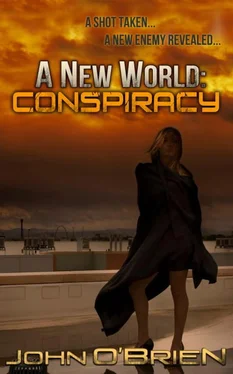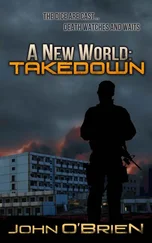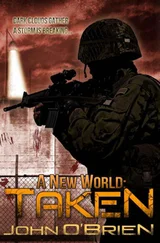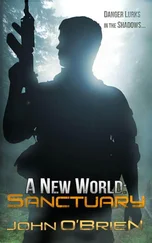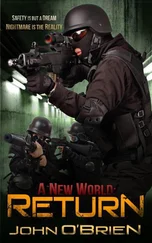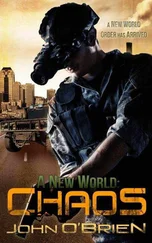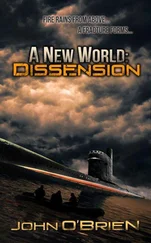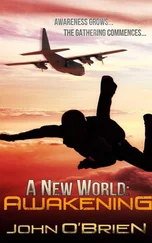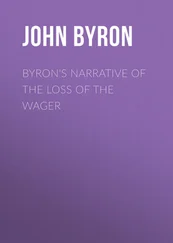“We’re here so we might as well enjoy the scenery,” Franklin says.
The others in turn shrug and Speer is surprisingly silent.
“Okay. Intervals, gentlemen. We’ll stay on the cliff side of the street. If we’re engaged in force, we’ll return fire and retreat down the bluff if possible. If not, we conduct a fighting retreat. The rally point will be the raft. If we become split, we wait at the raft provided we’re not under fire until two hours prior to sunset and then cast off with who we have. Secondary rally will be the start of the beach just north of this headland. Whoever casts off with the CRCC will rendezvous with the rest of the team there. One hour prior to sunset is the hard time to head to the Santa Fe . Questions?” Krandle briefs.
There aren’t any. “Okay, let’s get this over with.”
The road winds as it follows the contours of the headland. The early morning sun stretches the team’s shadows long to the west, disappearing over the edge. A very faint roar from the surf rises up the steep surface of the bluff. Birds flitter through the trees next to the houses and an occasional squirrel chitters warnings from tall branches. The team catches a brief sight of a cat as it slinks around the corner of one of the houses. In all, if it weren’t for the circumstances, it would be a peaceful stroll under a clear fall sky.
The team passes block after block. Many of the picture windows that once afforded scenic views of the Pacific reflect the blue sky. Some of the houses have their windows broken out and doors ajar. Tension mounts as they draw nearer to the area where the flashes occurred. They pause more often to take in their surroundings, taste the environment, and test their inner feelings for something amiss.
During one of their pauses, a flurry of noise erupts from their left, coming from bushes set between two houses. The team immediately drops into a posture to deliver concentrated fire. Krandle quickly verifies that the team is covering all avenues and aims at the sound — his red dot centered on the small opening between the bushes.
Uneasy about their situation in the open, he is about to open up to recon by fire when he sees the head of a large dog poke out. The animal stalks slowly out, tense and in an attack posture. Three others emerge behind it. The canine in front is a German Shepherd. Krandle isn’t able to identify what breed the others might be. Noticeable are their ribs showing through the skin and thin flanks. It’s obvious to Krandle that these dogs are underfed and live the entirety of their days searching for food. How they have kept away from the night runners during the dark hours is anyone’s guess. Krandle supposes they must sleep some during the day, perhaps chewing on the remains the night runners leave behind, and spend the evening avoiding the nocturnal predators.
Normally four wild dogs would avoid six grown men, so these must be desperate…and therefore dangerous. The Shepherd thrusts its head forward, baring its teeth and a low growl emanates from deep within it chest. Krandle stands to present his full height, knowing that it will either scare the dogs away or offer a challenge. One trick is to not look the dog in its eyes as that is definitely a challenge, but there’s no way Krandle dares look away.
The four dogs turn and back up a step before rounding on the team once again. The other three join in the growling which grows louder. Krandle feels sorry for them. They epitomize this new world — one in which it’s eat or be eaten. The leader settles back on its haunches and tenses.
Don’t , Krandle thinks, his barrel held unwavering toward the pack.
He lowers his barrel and fires a single round. The muted cough is barely heard over the growls. The round impacts the ground just in front and to the side of the leader with a ‘thwack’. The Shepherd reacts and jumps in the air with a yip. It lands and bares its teeth again, growling once before turning and vanishing quickly into the bushes, its companions follow behind.
With a nod from Krandle, the team continues their slow, cautious trek along the road. Krandle is anxious about being in the open and feels cornered. The Cliffside is both a benefit and possible liability. For one, it cuts the possible avenues of attack in half, but on the other side, it prevents an avenue of retreat.
The more Krandle thinks of the flashes, the more he becomes convinced they were from gunfire. Seeing it was at night means that whoever was here was more than likely firing at night runners. That means two things; one is that whoever it was is armed and that there are night runners in the area. The armed people worry him more. As long as they don’t go into buildings and are out of here by dark, the night runners shouldn’t offer trouble. The others…well, there are two possibilities there. They are either friendly…or not.
The team reaches a place where the road leaves the edge of the cliff and subtly curves inland to make room for houses built next to the escarpment. Krandle halts the team to carefully look over the region. They are in the vicinity of where the lights were observed. Nothing moves except the occasional swaying of branches in the breeze. Swirling patterns show in the fine covering of grit on the roadway, giving no indication that anyone passed recently. The tall grass in the yards stands straight, swaying in waves as drafts blow through. There aren’t any discernible paths.
“We’ll continue to the next intersection and call it good,” Krandle states over the radio. “Let’s move.”
The houses they encounter next to the cliff are some of the largest they’ve seen yet. Through gaps in trees and bushes, Krandle notes tennis courts in addition to the prerequisite swimming pools. Looped driveways lead in and out of each place. Small clumps of grass that would normally have been removed before they even showed themselves spring out of the cracks between the concrete partitions. The locale is completely quiet except for the swish of the passing wind.
Krandle feels the grit under his boots as he steps warily along the road with houses on both sides. All of the team members search the spaces between the structures, looking intently as if trying to peer through the bushes. Their suppressed muzzles tracking as their eyes search out different areas.
Feeling the inner tension build, Krandle calls a halt. He feels that something is wrong but can’t pinpoint exactly what — only that it’s a strong feeling. He has come to trust that feeling as it hasn’t led him astray yet. It’s telling him that his subconscious is picking out something that is not readily apparent to his other senses. Operators with time in the field know this sensation and rely on it as if it’s another sensory input. Someone or something is directing attention their way.
“I thought we were going to the next cross street,” Speer replies.
“Well, I—” Krandle begins.
He hears a shuffling of boots on the sandy surface behind him.
“Chief?” Krandle hears Miller sharply whisper.
Turning to look behind, he sees three figures dart across the road where the housing next to the cliff began. They cross toward the bluff side and vanish into one of the yards. Miller and Franklin are on their knees aiming their carbines back in the direction the team came from — Miller tracking where the three disappeared and Franklin covering where they emerged from.
“Movement ahead,” Speer calls.
Krandle looks quickly to see some bushes next to a house down the street ahead shake out of synch with the breeze. Looking across the street, he spots furtive movement in the dark shadows of the landscaped trees. His heart jumps as he recognizes the arranging of an ambush. From his initial observation, there appears to be quite a few taking positions around them. He quickly glances to the house set deep into the bluff-side lot immediately next to them. The front is more open than most of the other houses around and he doesn’t discern movement there.
Читать дальше
